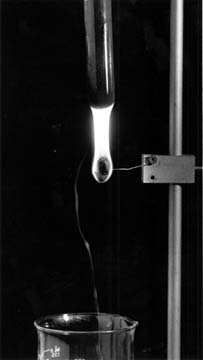Count Calories

Burn a peanut and use the heat to boil water.
Count Calories

Burn a peanut and use the heat to boil water.
Introduction
A peanut will burn producing an impressive amount of flame for a long time. The flame can be used to boil away water and count the calories contained in the peanut.
Material
Assembly
Bend the large paper clip as shown to make a peanut holder. Use tape to mount the paper clip in the center of the pie pan. The pie pan is necessary because the burning peanut may fall off the holder or drip flaming fat drops.
Place 10 mL of water into the test tube.
Mount the test tube in the holder over the paper
clip.
Tip the test tube at a slight angle, 30 degree or so, This will allow
the water to boil without forcing liquid water out of the
tube.
To Do and Notice
Find the mass of a whole peanut in grams.
Mount the peanut on the bent-paper clip peanut holder.
Make sure the peanut is a few centimeters under the test tube of water.
Make sure your hair and clothing is out of the way and will not be close to the burning peanut or the match.
Light the peanut, just hold the match under it, the peanut will catch on fire.
Notice the long burning flame.
Notice that the water in the test tube begins to boil
violently.
Let the peanut burn out and the test tube cool for 5 minutes or so.
Measure the amount of water left in the test tube and compute the volume and therefore mass of water that boiled away. My peanuts boiled away about 2 grams of water.
What's Going On?
The peanut burned.
Heat flowed from that burning peanut as combustion
converted the hidden chemical energy stored in the nut into the
easily measured energy of heat flow. When you eat a peanut, your body
does the same sort of thing: it converts the energy stored in the
peanut into the energy it needs to keep running.
The burning peanut raised the temperature of ten milliliters or ten
grams of water from tap water temperature, 20 °C, to the boiling
point, 100 °C then it boiled away 2 grams of water. This
information can be used to calculate the energy released by the
peanut 1880 calories. See
the calculation
One peanut released 1880 calories! Those of you who know about the calorie content of food may be shocked at this number. However food calories and physicist calories are different. One food Calorie contains 1,000 physicist calories. Notice how food calories are written with a capital C to indicate that they are different from physicist calories. So we captured 1.88 food Calories from the burning peanut.
The metric unit of energy is neither calorie, it
is the joule.
One food Calorie is equal to 4200 joules. So we captured a little
under 8000 joules from our burning peanut.
Going Further
Food scientists use a device known as a bomb calorimeter to measure the calorie content of foods. The bomb calorimeter does a better job of catching all of the energy released by the burning peanut. Experiments with a bomb calorimeter capture 6.3 Calories from a peanut the size of the one I used in my experiment, 1.0 gram. So my open air experiment captured less than a third of the calories released by the burning peanut.
Can you find ways to improve my experiment so that I capture more of the heat flow from my peanut?
Etc
Read my article on Counting Calories from the Exploring Food Magazine to learn more about the calorie content of peanuts and the operation of bomb calorimeters.
References
The Calorie Content of Foods, published by the U.S. Department of Agriculture gives the calorie content of many different foods.
Counting Calories, an article by Paul Doherty from the Exploring Food magazine.
Calculating the calories in a peanut.
To raise the temperature of 10 grams of water from 20 °C to 100 °C it takes:
Q = mcDT
where Q is the heat flow in calories
m is the mass of the water in grams
c is the specific heat of water which is 1 degree per calorie per
gram
and DT is
the temperature change in °C
Q = 10 * 1 * 80 = 800 calories
To boil 2 grams of water
Q = Lm
where L is the latent heat of vaporization of water, L= 540 calories per gram
Q = 540 * 2 = 1080 calories
The total energy needed is the sum of these two Q = 1880 calories.
|
Scientific Explorations with Paul Doherty |
|
19 October 2000 |